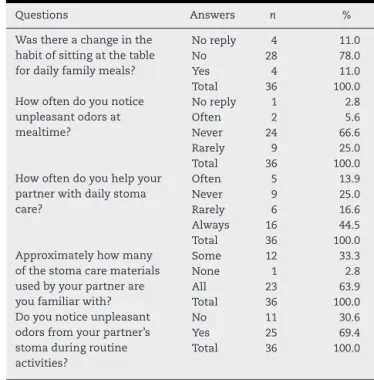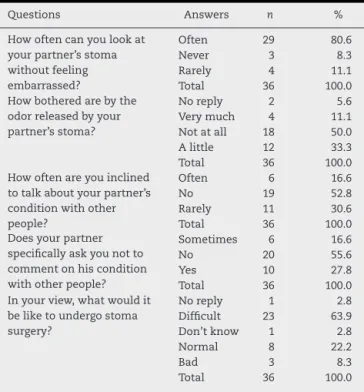Journal
of
Coloproctology
w w w . j c o l . o r g . b r
Original
article
Marital
interactions
in
partners
of
ostomized
patients
夽
Ana
Lúcia
da
Silva
a,∗,
Andréa
Mathes
Faustino
a,
João
Batista
Sousa
b,
André
Luiz
Vianna
b,
Paulo
Gonc¸alves
Oliveira
baDepartmentofNursing,UniversidadedeBrasília(UnB),Brasília,DF,Brazil
bDepartmentofSurgery,UniversidadedeBrasília(UnB),Brasília,DF,Brazil
a
r
t
i
c
l
e
i
n
f
o
Articlehistory:
Received14January2014 Accepted11August2014
Availableonline4September2014
Keywords:
Spouse Ostomy
Familyrelationships Psychologicaladaptation
a
b
s
t
r
a
c
t
Objectives:The present study aimed to investigate the sociodemographic profile of
ostomizedpatients,describetheirdailymaritalinteractions,andidentifytheseindividuals’ healthdemands.
Method:Thepresentinvestigationconsistedofadescriptiveandquantitativestudyof part-nersofostomizedpatients.
Results:Atotalof36individualswereinterviewed,ofwhom24(66.7%)werefemale. Par-ticipantswereagedbetween31 and70years,andreportedanannualfamilyincomeof $20,000.Thepresentstudyfoundthatthestomasurgerydidnotleadtosignificantchanges inmaritalrelationships.Thestudyparticipantsappearedtobesignificantlyinvestedin over-comingthebarriersimposedbytheirpartner’scondition.Respondentsalsodemonstrated dedication,sensitivityandawillingnesstohelptheirpartneradapttophysiologicaland gastrointestinalchanges.
Conclusion:Thechangesfollowingstomasurgeryalsohaveanimpactonpatients’partners, andbothindividualsmustworktogethertokeepitasecretifnecessary.Thepresentresults madeitclearthatrespondentsempathizedwiththeirpartners,andagreedthatundergoing stomasurgeryisadifficultordeal.
©2014SociedadeBrasileiradeColoproctologia.PublishedbyElsevierEditoraLtda.All rightsreserved.
O
cotidiano
da
convivência
conjugal
com
a
pessoa
estomizada
Palavras-chave:
Cônjuges Estomia
Relac¸õesFamiliares Adaptac¸ãopsicológica
r
e
s
u
m
o
Objetivos:Conheceroperfilsócio-demográficodosparticipantes,descreveromodode con-vivêncianocotidianonacondic¸ãodeparceirodoestomizadoeidentificarademandade cuidadosnocontextofamiliar.
Métodos:Trata-sedeestudodescritivo,denaturezaquantitativa,realizadocomparceirosde estomizados.
夽
ThisstudywasconductedintheGraduateProgramofMedicalSciences,SchoolofMedicine,UniversityofBrasilia,Brasília,DF,Brazil.
∗ Correspondingauthor.
E-mail:analucia@unb.br,formato@scientific.com.br(A.L.daSilva).
http://dx.doi.org/10.1016/j.jcol.2014.08.005
Resultados: Foramrealizadas36entrevistascomparceirosdeestomizados,sendo24(66,7%) dosexofeminino.Aidadedosentrevistadosvariouentre31a70anos.Arendafamiliar mensaldamaioriadosentrevistadosequivalecercade20.000dólaresanuais.Asalterac¸ões nocotidianonavidadocasalnãogerarammudanc¸assignificativasnosseushábitosem consequênciadaestomia.Osentrevistadosprocuramsuperarosobstáculosdo enfrenta-mentodanovacondic¸ãodoseuparceiroestomizadoedemonstramdedicac¸ão,apoioe acompanhamento,notocanteaadaptac¸ãodasmodificac¸õesfisiológicasegastrointestinais.
Conclusão: Asmudanc¸asimpostasaoestomizadoéumasituac¸ãopartilhadaentreocasal comoobjetivodemanteracondic¸ãoemsigilo.Ficouclaroeexplicitonapesquisaque,na interpretac¸ãodoentrevistado,acondic¸ãodeestomizadoémuitodifícil.
©2014SociedadeBrasileiradeColoproctologia.PublicadoporElsevierEditoraLtda. Todososdireitosreservados.
Introduction
In recent decades, an increasing number of studies have beenconductedonpatientswhounderwentstomacreation. Most of these studies have investigated stoma care, skin protectionandtypesofostomyequipment.Althoughthe emo-tional,familialandsocialaspectsoftherelationshipbetween ostomizedindividualsand theirpartnersmayalsohavean importantimpactonpatienthealth,thislineofresearchhas beenneglectedintheliterature.
Maritalrelationships aredistinct from other social rela-tions in that they require both emotional and physical involvementbetweentwoindividuals.Thestabilityofmarital relationshipshasbeensuggestedtobeoneofthestrongest determinantsofqualityoflifeincouples.Studies offamily dynamicshavesuggestedthatmaritalsatisfactionand stabil-itymustbemorecomprehensivelystudied,especiallythrough investigationsofthedailyfrequencyofpositiveandnegative interactionsbetweencouples.1
Arecentreviewofurinaryincontinenceinmenhighlighted thepsychologicalsufferingofthepatients’partnersduetothe emotional,sexualandsocialimpactofthemen’scondition.2
Similarly,thechangesexperiencedbypatientsafteranostomy surgerymayalsohaveanimpacton theirpartner’s behav-ior.Giventheirproximitytothepatient,thepartnerisoften involvedindailystomacare,andmayattimestakeontherole ofacaregiver.
Individualswithintestinalstomaoftenreportdifficultiesin interactingwiththeirpartnerinanaturalway,astheybelieve thatitmaybedifficultforthepartnertobephysicallyclose tothem,toparticipateinthesamesocialactivities,andtoeat withthematfamilymeals.Duetolossofsphinctercontrol, theinvoluntaryreleaseofgas,fecesandunpleasantodorsis acommonoccurrenceinthesepatients,andmayconsistof anadditionalbarriertosocialinteractions.3Inlightofthis
sit-uation,itisimportanttoquantitativelyassessthebehavior ofostomizedpatientsandtheirpartners,soastobetter com-prehendtheirsocialrealityandtoknowhowbesttoassist theseindividuals.Therefore,thepresentstudywasguidedby thefollowingresearchquestions:Howdoesintestinalostomy surgeryaffectthepatient’sandtheirpartner’slife?Whatis the impactofsuch aprocedure on dailyfamily and social activities?
Basedonthesequestions,thepresentstudyaimedto inves-tigatethesociodemographicprofileofostomypatientsandto describetheirrelationshipswiththeirpartners.
Method
Thiswasadescriptive,quantitativestudy,conductedon part-ners of ostomized patients. The present investigation was approvedbythe HumanResearchEthics Committeeofthe UniversityofBrasiliaSchoolofMedicine,underprotocol num-ber(CEP-FM011/2009).
DatawascollectedfromthetreatmentregistryoftheStoma CareUnitoftheStateDepartmentofHealth(SESDF).Asof October 2011,a total of685 adultand pediatric ostomized patientswereregisteredattheOutpatientHealthService.
Inthepresentstudy,thespousesorpartnersofostomized patientswereinterviewed,regardlessoftheirlegalmarital sta-tus.Thefollowinginclusioncriteriawereused:agreementto participateinthestudyandabilitytoprovidewritteninformed consent;age18oroveratthetimeofthestudy;fluencyin writ-tenandspokenPortuguese;havinglivedwiththeostomized patientforatleastoneyearbeforethestomaprocedure,and continuingtolivewiththemafterwards.
DatawerecollectedbetweenOctober2011andMay2012, using a questionnaire designed specifically for use in the present study.Theinstrumentwasdevelopedbasedonthe presentauthors’extensiveclinicalexperiencewithostomized patients,withwhomtheauthorshavebeencloselyinvolved forover20years.
Table1–Gender,age,education,familyincomeand durationoftherelationshipofpartnersofostomized patients(n=36),Brasília,DF–2012.
n %
Gender
Female 24 66.7%
Male 12 33.3%
Agerange
31to40years 5 13.9%
41to50years 11 30.6%
51to60years 10 27.8%
61to70years 6 16.6%
Over70years 4 11.1%
Educationlevel
Incompleteprimary 4 11.1%
Completeprimary 8 22.2%
Incompletesecondary 2 5.6%
Completesecondary 8 22.2%
Highereducation 14 38.9%
Durationofrelationship
1to2years 1 2.8%
2to5years 0 0.0%
Over5years 35 97.2%
Familyincome
Uptooneminimumwage 1 2.8%
1to2minimumwages 10 27.8%
2to5minimumwages 6 16.6%
Over5minimumwages 19 52.8%
Total 36 100.0%
Thequestionnairewasindividuallyadministeredtoeach participant,andnootherpeoplewerepresentatthetimeof assessment.Theresearcherremainednearbytoanswerany questionsorprovideclarification.
Data were analyzed between July and December 2012 usingtheSPSS(StatisticalPackageforSocialSciences) soft-ware,version16.0forWindows.Resultswereobtainedthrough descriptiveanalyses.
Results
Thefinalsamplewascomposedof36partnersofostomized patients,mostofwhom werefemale(n=24;66.7%). Partici-pantswereagedbetween31and70years,andalargenumber ofindividualshadauniversityeducation(n=14;38.9%).The monthly income of most participants (n=19; 52.8%) was greaterthanthreetimestheminimumwage.Avast major-ityofparticipantshadbeeninacommon-lawrelationshipfor over5years(n=35;97.2%),and16participants(44.4%)reported thattheirpartnerhadundergoneostomysurgeryatleast5 yearsbeforedatacollection.Furtherdetailsonthesevariables aredescribedinTable1.
Mostoftheparticipants’partnershadundergonea defini-tive(n=28;78.0%)ratherthanatemporarystoma.
Table2containsdataregardingthedailyroutineof partici-pantsandtheirpartners.Atotalof28(78.0%)participantsstill hadmealswiththeirpartnersafterthe stomasurgery,and only4(11.1%)participantsreportedtohavingchangedthis
Table2–Resultsregardingthedailyroutineofstoma patientsandtheirpartners.(n=36),Brasília,DF–2012.
Questions Answers n %
Wasthereachangeinthe habitofsittingatthetable fordailyfamilymeals?
Noreply 4 11.0
No 28 78.0
Yes 4 11.0
Total 36 100.0
Howoftendoyounotice unpleasantodorsat mealtime?
Noreply 1 2.8
Often 2 5.6
Never 24 66.6
Rarely 9 25.0
Total 36 100.0
Howoftendoyouhelpyour partnerwithdailystoma care?
Often 5 13.9
Never 9 25.0
Rarely 6 16.6
Always 16 44.5
Total 36 100.0
Approximatelyhowmany ofthestomacarematerials usedbyyourpartnerare youfamiliarwith?
Some 12 33.3
None 1 2.8
All 23 63.9
Total 36 100.0
Doyounoticeunpleasant odorsfromyourpartner’s stomaduringroutine activities?
No 11 30.6
Yes 25 69.4
Total 36 100.0
habit.Theremainingparticipantsdidnotanswerthis ques-tion.
Twenty-four respondents (66.6%)reported tonever hav-ingnoticedanyunpleasantodorscomingfromthepartner’s intestinal stoma duringfamily meals, and 9(25%) respon-dentsclaimedtheyonlyrarelynoticedsuchsmellsatmeals. Tworespondents(5.6%)saidtheyfrequentlynoticedtheodors comingfromtheirpartner’sstomaduringfamilymeals.
Thefrequencywithwhichparticipantshelpedwithdaily stomacarewasalsoinvestigated.Sixteen(44.5%)respondents reportedtoalwayshelpingwiththeseactivities,whilenine individuals (25.0%) neverhelped their partner.Another six (16.6%) individuals rarely helped their partners, while five (13.9%)reportedtofrequentlyhelpingwithdailystomacare. Atotalof23respondents(63.9%)werefamiliarwithallostomy materialsusedbytheirpartner,while12(33.3%)werefamiliar withsomeofthematerials.Onlyasinglerespondent(2.8%) wascompletelyunfamiliarwithostomymaterials.
Lastly,itwasfoundthatmostrespondents(n=25;69.4%) couldsmelltheunpleasantodorscomingfromthepartner’s stoma,while11(30.6%)individualsdidnotnoticethesesmells.
Table3displaysparticipants’answersregardingtheir emo-tionalandbehavioralresponsestotheirpartner’sstoma.Most participants(n=29;80.6%)frequentlylookedattheirpartner’s stoma,while4(11.1%)respondentsrarelylooked atit.The remainingparticipantshadneverseentheirpartner’sstoma (n=3;8.3%).
Althoughtheycouldsmellunpleasantodorscomingfrom thestoma,18(50%)respondentswerenotbotheredbythem,12 (33.3%)thoughtthemslightlyinconvenientandonly4(11.1%) feltverybotheredbythem.Theremainingparticipants pre-ferrednottoanswerthequestion.
Table3–Feelingstowardstomasurgeryasreportedby thepartnersofostomizedpatient.
Questions Answers n %
Howoftencanyoulookat yourpartner’sstoma withoutfeeling embarrassed?
Often 29 80.6
Never 3 8.3
Rarely 4 11.1
Total 36 100.0
Howbotheredarebythe odorreleasedbyyour partner’sstoma?
Noreply 2 5.6
Verymuch 4 11.1 Notatall 18 50.0 Alittle 12 33.3
Total 36 100.0
Howoftenareyouinclined totalkaboutyourpartner’s conditionwithother people?
Often 6 16.6
No 19 52.8
Rarely 11 30.6
Total 36 100.0
Doesyourpartner specificallyaskyounotto commentonhiscondition withotherpeople?
Sometimes 6 16.6
No 20 55.6
Yes 10 27.8
Total 36 100.0
Inyourview,whatwouldit beliketoundergostoma surgery?
Noreply 1 2.8
Difficult 23 63.9 Don’tknow 1 2.8
Normal 8 22.2
Bad 3 8.3
Total 36 100.0
frequentlyinclinedtotalkabouttheirpartner’ssituationwith otherpeople.
Mostinterviewees (n=20;55.6%)claimedthattheir part-nershadnotrequestedthemtokeeptheirstomasurgerya secret.Tenrespondents(27.8%)saidtheirpartnersspecifically askedthemnottospeakoftheirconditiontoothers,and6 (16.6%)individualssaidtheirpartnerssometimesaskedthem nottocommentontheirsituation.
Twenty-threeparticipants (63.9%)said theywould think itdifficulttoundergostomasurgery,while8(22.2%) consid-ereditanormalprocedureand3(8.3%)thoughtitwouldbe bad.
Discussion
Thepresentstudy investigatedanumber ofaspectsofthe relationshipbetweenostomizedpatientsandtheirpartners, suchaschangesinthehabitofsittingatthetablefor fam-ilymeals,theperceptionofunpleasantsmellscomingfrom thepatient’sstoma,thepartner’sroleinhelpingthepatient withdailystomacareactivities,thepartner’sfamiliaritywith ostomymaterials,theirabilitytolookatthestomawithout beingembarrassed,and theirperceptionsoftheirpartner’s ostomysurgery.
Mostparticipantswerebetween31and60yearsold,and therefore,itcanbeassumedthattheostomizedpatientswere inthesameagerange.Thesefindingsdifferfromanumberof studies4–7whosesamplesofostomizedpatientswerelargely
composedofindividualswhowereatleast60yearsold.Most ofthestudyparticipantswerealsofemale,hadcompleted uni-versityeducationandhadbeenwiththeirpartnerforoverfive years.
Thisobservation,combinedwiththefactthatall individ-ualsincludedinthestudyhadbeeninarelationshipwiththeir
partnerforatleastoneyearpriortotheirstomasurgery, sug-geststhatindividualstendtoremaininstablerelationships andtobesupportedbytheirpartnersfollowingtheprocedure. Individualswhohadnotbeeninarelationshippriortothe stomasurgeryaregenerallymorelikelytoremainsingleafter theprocedure.3
Meanfamily incomewas over five minimumwages for moststudy participants,whichsuggestedtheseindividuals earnedapproximatelyUSD20,000ayear.
Participantsreportedthattheirpartnershadhada defini-tiveintestinalstomaforoverfiveyears,whichspeakstothe increase in the lifeexpectancy ofostomized patients. The highratesofdefinitivestomafoundinthepresentstudywere similartothosereportedinotherstudiesintheliterature.5,7
Most ostomized patients investigatedin the present study wereyoung,andwerelikelytoliveforalongtimeaftertheir surgery.
Whenaskedaboutchangesinthehabitofsittingdownfor familymealswiththeirpartner,mostrespondentsreported thatthisdidnotchangefollowingtheirpartner’sstoma proce-dure.However,thisisasomewhatcontroversialfinding,since anumberofpreviousstudieshaveshownthatlimitsonthe intakeofcertainfoodsaswellastheinvoluntaryreleaseof gasfollowingtheostomysurgeryleadpatientstoavoidsocial contact,anddecreasethepleasurederivedfromeatingfood. Toavoidembarrassmentduringmeals,thesepatientsoften avoidsocialization atmealtimesand rarelyeat inpublic.3
Theseindividuals mayalsomakeextremechangestotheir diet,duetoafearofbeingdiscriminatedbyindividualswho arepartoftheirsocialcircle,suchasfamilyandfriends.8
Mostsurveyrespondentsreportedtoneverhavingnoticed unpleasantsmellsduringmealswiththeirpartner.However, a significant number of study participantsdid notice such smellsinthesesituations.
Theinabilitytocontroltheodorreleasedfromthestoma isa majorsourceofworryformostpatients. Tosolve this problemandmaintainregularsocialactivities,patientsoften exercisestrictcontrolovertheirdietinanattempttoregulate intestinalfunction.8
Anumberofstudiesintheliteraturehaveoffereddietary recommendationsforostomizedpatientsbasedonthe likeli-hoodthatdifferentfoodswillleadtotheinvoluntaryrelease ofgasandunpleasantodors,orcausegastrointestinal impair-ment and other complications. However, few studies have looked into the environment in which ostomized patients havetheirmeals.
Mostofthestudyparticipantsreportedtoalwayshelping theirpartnerswithdailystomacareactivities.These individ-uals appearedtobededicated andwilling tocarefortheir partner.However,asignificantnumberofindividualsreported toneveroronlyrarelyhelpingtheirpartnerstocarefortheir stoma.
Thefactthatsomeindividualsdidnotusuallyhelptheir partnercouldbeexplainedbythefactthatthepatienthimself maynotbecomfortablewithsuchactionsduetoshameand fearofnotbeingacceptedbytheirpartneroncetheysawhim inthatcondition.Self-rejectionisacommonphenomenonin ostomizedpatients.9
patient’sownhome,sothatattimes,theirpartnerisleftwith nochoicebuttohelpwiththesetasks.10Studieshavefound
that,whenplacedthesesituations,patients’partnersmayfeel embarrassedorevendisgusted.10Therefore,althoughitmay
beachallengingtaskforthepatient’spartner,hemustprovide helpandsupportsothatthepatientcanovercometheeffects ofhisnewcondition.
Whenthepartners’familiaritywithstomacarematerials wasinvestigated,itwasfoundthatmostpartnerswere famil-iarwithallostomyequipmentusedbytheirpartner,whilea thirdwerefamiliarwithatleastsomeoftheseinstruments. Onlyasingleparticipantreportedtonotknowinganyostomy materials.
The wide variety of ostomy bags and similar materi-als available on the market may allow patients to select their equipment in the way that best suits their needs.7
Both the patient and their partner must be familiar with these materials so as to facilitate their selection and use ofostomy appliances. Thecontinuoususe ofthese materi-alsrequiresrigorousmedicalfollow-up,sinceostomydevices may need to be changed or replaced over the course of treatment.
Ifthestomapatient’spartnerexpressesrejectionordisgust whilehelpinghimwithself-careactivities,thepatientmay,in turn,experienceconflictingfeelingsofrepulsionand compas-sion.Inthesecases,itisbestthatthepartnerdoesnotassist thepatient.10Inthepresentstudy,participantsreportedthat
theynoticedunpleasant odorscomingfrom theirpartner’s stomaonadailybasis.Whenaskedwhether thisbothered them,halftheparticipantsanswerednegatively,andonlytwo participantsdeclinedtoanswer.Theremainingparticipants answeredaffirmatively.
Participantsinthepresentstudyreportedthattheyoften lookedattheirpartners’stoma.Thesedataarenotin agree-mentwithpreviousresearch,3whichshowedthatindividuals
didnottend tolookattheir partner’sstoma. Thismay be interpretedasanexpressionofrejection.
Datafromanotherstudy,which,likethepresent investiga-tion,wasalsoconductedonpartnersofostomizedpatients, didnotfindthatparticipantsexpressedrejectiontowardtheir partners.Basedontheseresults,theauthorsconcludedthat bothpartiesinthecouplehadbeenabletofindadaptiveways todealwiththeirsituation.10
Thepresentstudy alsofoundthatapproximatelyhalfof therespondentsdidnotdiscusstheirpartner’ssituationwith membersoftheirsocialcircle.However,thiswasnotan exter-nalimposition,asthesamepercentageofindividualsreported thattheirpartnershadnotaskedthemtoavoiddiscussing theirconditionwithothers.Theseresultscontrastwiththose ofapreviousstudywhichfoundthatostomizedpatientsoften isolatethemselves duetoshame,and hide theircondition fromothers.3
Thepresent datasuggestedthatanumberofostomized patientsmaynotworry aboutbeingidentifiedassuch,and havenoproblemswiththeirpartnerdiscussingtheircondition withothers.Althoughostomizedpatientsmaynotexplicitly forbidtheirpartnersfromcommentingontheirconditionwith others,thepartnersthemselvesmaynoticesome embarrass-mentabouttheostomyonthepatient’spart,and basedon thisperception,decideagainstdiscussingthesituationwith
theirpeers.Therefore,whilekeepingthepatient’sconditiona secretmaynotalwaysbeaneasytask,ahighnumberof par-ticipantsinthepresentstudyreportedtohelpingtheirpartner inthisregard.
Lastly,amajorityofstudyparticipantsrespondedthatthey wouldconsiderit“difficult”toundergostomasurgery.
Thepresentstudyhadsomelimitations.Firstly,thescarcity ofsimilarinvestigationsintheliteraturelimitedcomparisons betweenthepresentfindingsandthoseofotherstudies. Sec-ondly,theintimatenatureoftheissuesdiscussedmayhave influenced results, as the accuracy and reliability of self-reportsofpersonalissuessuchasmaritalrelationshipscan beinfluencedbyanumberofmethodologicalandassessment issues.
However,inspiteoftheselimitations,thepresent study was able to report that a number of aspects of marital functioningmayremainunchangedafteroneoftheparties undergoesstomasurgery.Therespondentsappearedtomake an effort towardovercoming thebarriers imposed bytheir partner’scondition,anddemonstrateddedication,sensitivity andawillingnesstohelptheirpartneradapttophysiological andgastrointestinalchanges.
Thechangessufferedbytheostomizedpatientsare actu-ally shared by the couple, and both parties must work towardadaptingtothe conditionand keepingit asecretif necessary.
Thepresent resultsalsomade it clearthatrespondents empathizedwiththeirpartners,andagreedthatundergoing stomasurgeryisadifficultordeal.
Conflicts
of
interest
Theauthorsdeclarenoconflictsofinterest.
r
e
f
e
r
e
n
c
e
s
1.MosmannC,FalckeD.Conflitosconjugais:motivose frequência.RevistadaSPAGESP.2011;12:5–16.
2.BicalhoMB,LopesMHBdM.Impactodaincontinênciaurinária navidadeesposasdehomenscomincontinência:revisão integrativa.RevEscEnfermUSP.2012;46:1009–14.
3.SilvaAL,ShimizuHE.Osignificadodamudanc¸anomodode vidadapessoacomestomiaintestinaldefinitiva.Rev Latino-AmEnfermagem.2006;14:483–90.
4.PereiraAPdS,CesarinoCB,MartinsMRI,PintoMH,NetinhoJG. Associac¸ãodosfatoressociodemográficoseclínicosà qualidadedevidadosestomizados.RevLatino-Am Enfermagem.2012;20:93–100.
5.ViolinMR,MathiasTAdF,UchimuraTT.Perfildeclientes colostomizadosinscritosemprogramadeatenc¸ãoaos estomizados.RevEletrEnf.2008;10:924–32.
6.RamosRdS,BarrosMD,dosSantosMM,GawryszewiskiARB, GomesAMT.Operfildospacientesestomizadoscom diagnósticoprimáriodecâncerderetoemacompanhamento emprogramadereabilitac¸ão.CadSaúdeColet.
2012;20:208–86.
8. SilvaDG,BezerraALQ,SiqueiraKM,PranaguáTTB,Barbosa MA.Influênciadoshábitosalimentaresnareinserc¸ãosocial deumgrupodeestomizados.RevEletrEnf.2010;12:56–62.
9. SantanaJCB,DutraBS,TameirãoMA,SilvaPF,MouraIC, CamposACV.Osignificadodesercolostomizadoeparticipar
deumprogramadeatendimentoaoostomizado.Cogitare Enferm.2010;15:631–88.

